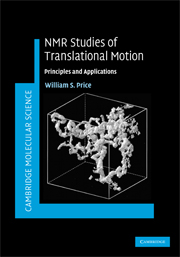Book contents
- Frontmatter
- Contents
- Preface
- Acknowledgements
- Abbreviations
- 1 Diffusion and its measurement
- 2 Theory of NMR diffusion and flow measurements
- 3 PGSE measurements in simple porous systems
- 4 PGSE measurements in complex and exchanging systems
- 5 PGSE hardware
- 6 Setup and analysis of PGSE experiments
- 7 PGSE hardware and sample problems
- 8 Specialised PGSE and related techniques
- 9 NMR imaging studies of translational motion
- 10 B1 gradient methods
- 11 Applications
- Appendix
- Index
- References
2 - Theory of NMR diffusion and flow measurements
Published online by Cambridge University Press: 06 August 2010
- Frontmatter
- Contents
- Preface
- Acknowledgements
- Abbreviations
- 1 Diffusion and its measurement
- 2 Theory of NMR diffusion and flow measurements
- 3 PGSE measurements in simple porous systems
- 4 PGSE measurements in complex and exchanging systems
- 5 PGSE hardware
- 6 Setup and analysis of PGSE experiments
- 7 PGSE hardware and sample problems
- 8 Specialised PGSE and related techniques
- 9 NMR imaging studies of translational motion
- 10 B1 gradient methods
- 11 Applications
- Appendix
- Index
- References
Summary
Introduction
As soon as the spin-echo was discovered by Hahn in 1950 it was realised that it could form the basis of self-diffusion measurements. Indeed, certainly within the next decade the concept of spin-echo-based diffusion measurements using static magnetic gradients (i.e., Steady Gradient Spin-Echo or SGSE NMR) had become widespread and used in quite sophisticated measurements such as on water and 3He. Many of the experimental limitations of static gradient measurements were removed with the suggestion in 1963 by McCall, Douglass and Anderson and experimental introduction in 1965 by Stejskal and Tanner of applying the magnetic gradients as pulses in the spin-echo sequence (i.e., Pulsed Gradient Spin-Echo NMR or PGSE NMR). Carr and Purcell were the first to discuss NMR flow measurements and in 1960 NMR flow measurements were considered for the purpose of measuring sea-water motion.
Virtually all contemporary NMR diffusion (and flow experiments) are based on some form of spin-echo. Indeed, for all but the simplest cases the dependence of the observed echo amplitudes on diffusion rapidly becomes very complicated and this can be exacerbated in pulse sequences where the magnetisation is kept in a steady state. However, in the following discussions we will assume, unless otherwise noted, that all pulse sequences start with the spin system being in thermal equilibrium (i.e., M0). As the diffusing species necessarily contains a nuclear spin, the terms spin and particle will henceforth become synonymous.
Information
- Type
- Chapter
- Information
- NMR Studies of Translational MotionPrinciples and Applications, pp. 69 - 119Publisher: Cambridge University PressPrint publication year: 2009
References
Accessibility standard: Unknown
Why this information is here
This section outlines the accessibility features of this content - including support for screen readers, full keyboard navigation and high-contrast display options. This may not be relevant for you.Accessibility Information
- 2
- Cited by
